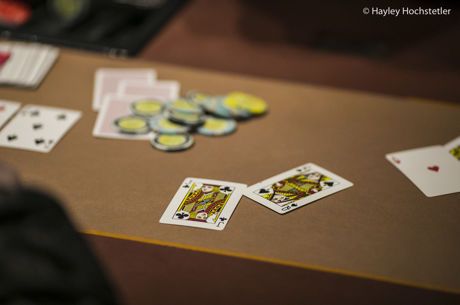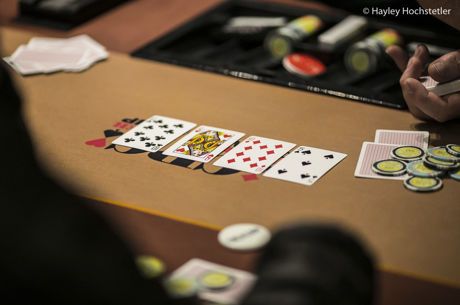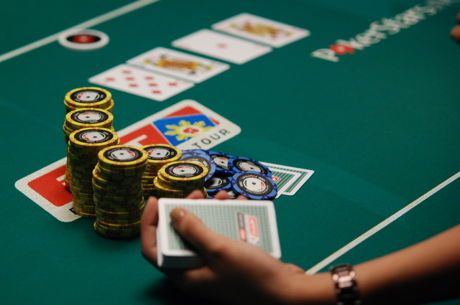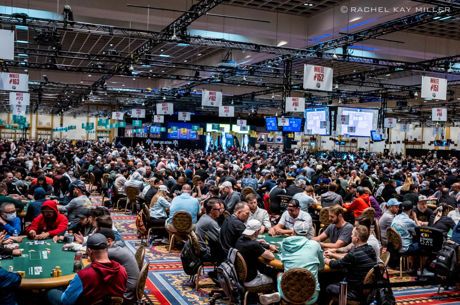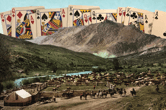Responding to Unexpected Leading Bets Postflop
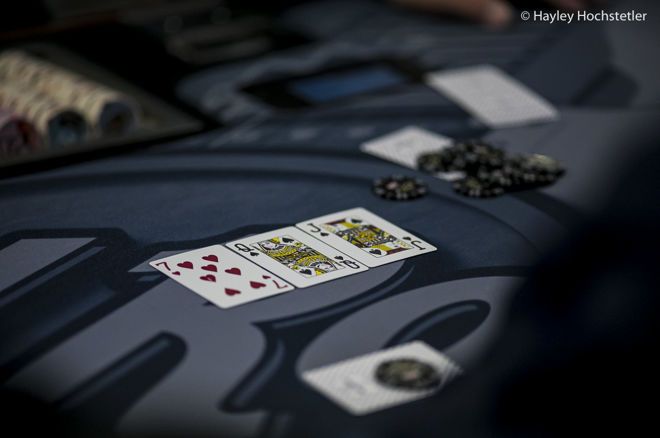
In no-limit hold'em, whenever we are battling with opponents postflop, there will always be some community cards that are better for our range and some that are better for our opponents' range.
When a card comes that hits our opponents more often than us, they are entitled to bet. When another comes that hits us more than them, they aren��t. When they do bet anyway, we have to ask ourselves, what is their motivation? Do they know the card is good for us, but have a value hand, so need to bet regardless? Or could they have a bluff, because they don��t realize the card��s value to our range of hands?
Let��s take a look at an example of just such a situation, one where a card appears that should hit our range better than our opponent's, but our opponent is firing a bet nonetheless.
A Flop That Hits Our Range (More Than Our Opponent's)
It's a $50 no-limit hold'em daily freezeout, and it folds to us in the cutoff where we've been dealt A?10?. It's the final table, and we have about 30 big blinds and are currently third in chips. Meanwhile the shortest stack has 25 BBs, so we are not in a position to wait him out. Nor is the next pay jump of much significance in the overall scheme.
Of course, it being a final table, we should value our tournament life. But there is no extraordinary ICM pressure in our situation.
We make a min-raise and only the big blind calls, and the flop comes K?J?4?. Our opponent checks. We continuation bet half-pot and he calls.
In this spot we are unlikely to see a check-raise from an experienced player. Looking at that flop, our range has the strongest hands in it more often than our opponent's range does and his range is quite a bit weaker overall than ours.
The big blind has a lot of hands with two cards falling in between the four and jack, and typically we only have the suited versions of these complete misses. On the other hand, we have more high cards as a proportion of our raising range than the big blind has high cards as a proportion of a defending range.
Both things are working against our opponent: we have more hits, he has more misses. That means playing defensively out of position.
Turn Out of Tempo
The turn card is the Q? and our opponent leads into us with a bet of 3 big blinds (about a third of the pot).
That turn has given us the ace-high straight with a nut flush redraw, plus a royal flush gutshot. Being another high card, the turn suits our flop betting range for the same reason it suited our preflop raising range. Our opponent��s range, however, is now remarkably different than it was when he checked to us on the flop. That is because he continued with a call.
Our flop bet wins us the pot pretty much every time our opponent misses. But when our opponent calls the flop from out of position, we can start assuming this is not one of those times.
Now if there is something that is different between our flop-betting range and the big blind's flop-calling range, it is the depth of suited diamonds. For example, we never raise 5?3? from this position, but our opponent can certainly call from the big blind with that same hand when facing a min-raise. The same goes for 10?7? and so on.
In other words, he has strictly more combinations of flushes on this card than we do. While we might have the nut flush more often than him when we hold a flush, our range is heavily weighted to one- and two-pair hands with some straights, while he has one-pair hands with some flushes.
For this reason we should be cautious about raising for value. We risk only getting action from better hands. This leading bet into us also should make us question our opponent��s motivations. Yes he may have a handful more flushes than we do, but don��t we still have the range advantage? Calling with suspicion is the play here.
River Heat
The river is the 10?, making the final board K?J?4?Q?10?, and our opponent shoves all in. There are about 16 BBs in the pot and the bet is for about 18 BBs effective. Now our ace-high straight is still the best straight, but it is very easy for us to hold the best straight. If we have Broadway so easily in this situation, why is our opponent moving all in against us?
Back to the original premise �� if our opponent is skilled, he knows we can easily hold A-A, A-K, A-Q, A-J, A-T, A?Xx, X?X?, and even some A-5, A-4, A-3, and A-2 hands. He would never expect us to fold these hands. He knew the turn card was unlikely to be a good bluff opportunity for him, but he bet it anyway.
Against this type of opponent, we should fold this hand �� we need a flush to call.
If our opponent is clueless, things are murkier. Poor players who like to bluff will do so on bad cards. In that case our hand looks like an ideal bluff catcher. We have the best straight and the best diamond blocker. If he is capable of bluffing, it might be time to call down.

